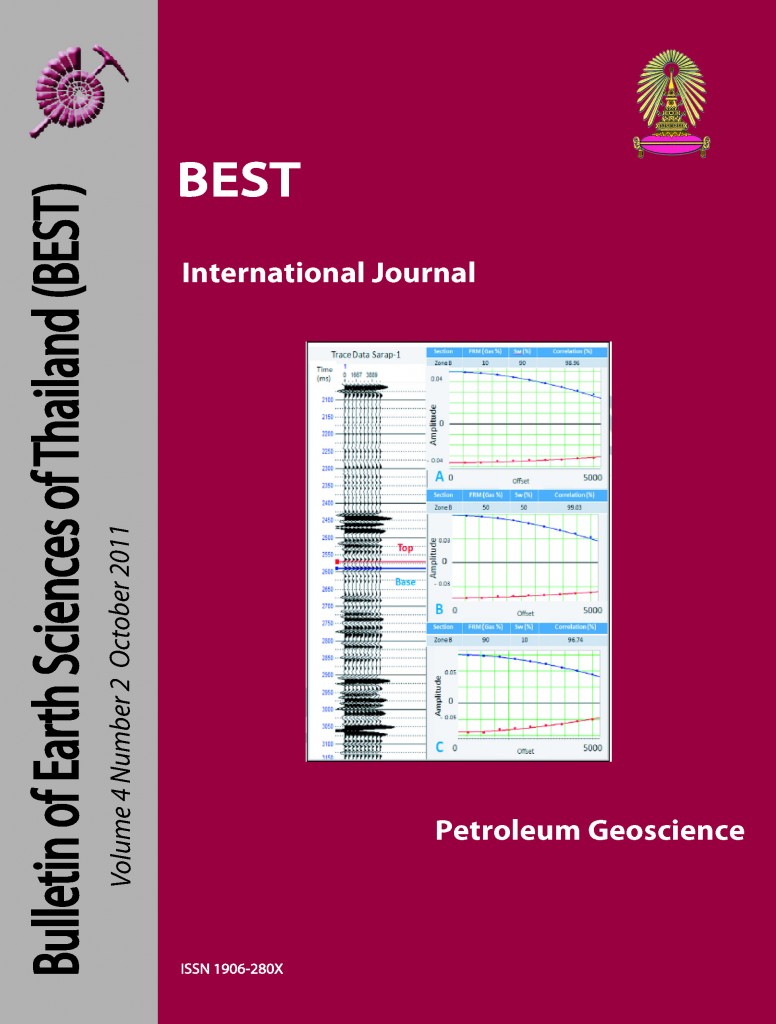Fluid History of Hydrothermal Textures in an Exposed Quarry in Chumphae District, Khon Kaen Province, Northeast Thailand
Main Article Content
Abstract
Fractured reservoirs produce gas in the Phu Horm & Nam Phong region of NE Thailand, but the reasons for this production, as well as timing of the fracturing and porosity enhancement in the Permian limestone host are poorly documented and not well understood. Fractured and brecciated analogues to Phu Horn reservoir outcrop were studied within a nearby quarry on the western margin of the Khorat Plateau, near Chum Phae, KhonKaen. There we have exposures of different types of local fault-controlled breccias and more widespread less disturbed non-breccia areas, with distribution patterns controlled by the interactions of tectonic fracturing and fluid flow. Detailed measurements of fracture orientation and density in the quarry show that the scale of fracturing, the fracture trends, and distances between fracture corridors are not unlike similar scale features in Phu Horn field, but the maximum horizontal stress directions are not the same.
In the quarry, the integration of outcrop observations (fracture orientations and mesoscale textures) with microscale laboratory analyses (thin section, XRD and stable isotope determinations) define the timing of fracturing in relation to episodes of tectonically-driven fluid flow. Stable isotopes were collected from a series of matrix blocks and calcite veins in both the brecciated and non-brecciated zones. The integration of the stable isotope measurements in these two zones, with the thin sections collected from the same sample sites, shows that matrix blocks in non-brecciated zones are less altered than matrix in the brecciated zones. Matrix blocks in brecciated zones show evidence of pervasive hydrofracturing, indicated by dense networks of criss-crossing microveins and a re-equilibration in the isotope data.
The matrix in the nonbrecciated zone preserves the regional burial signal typical of the Permian carbonates of northern and central Thailand. In contrast the micro-veined hydrofractured matrix in the breccias and all the calcite from fractures in both zones show the influence of a carbon-depleted organically-influenced fluid source, tied to a tectonically-driven fluid flow event. This event is later than burial during the Indosinian Orogeny and may be as young as mid Cenozoic. It is not related to modern meteoric karstification.
Based on this new isotopic insight, we now know that there was pervasive hydrofracturing during overpressuredriven deformation in northern Thailand. It occurred in a tectonically-drivenmethanogenically-influenced fluid escape event. It is likely that this fluid event played an important role in the development of fractured reservoirs in the subsurface of northern Thailand.
Article Details

This work is licensed under a Creative Commons Attribution-NonCommercial-NoDerivatives 4.0 International License.
Copyright © 2008 Department of Geology, Faculty of Science, Chulalongkorn University. Parts of an article can be photocopied or reproduced without prior written permission from the author(s), but due acknowledgments should be stated or cited accordingly.
References
Ampaiwan, P., 2011, Structural development of thrusts, folds and fractures in quarry exposures or Permian limestones, Saraburi province, central Thailand: Implication for fracture reservoir development in NE Thailand: Master thesis of Chulalongkorn University, Bangkok, Thailand, 44 pp.31
Baird, A., and D. Bosence, 1993, The sedimentological and diagenetic evolution of the Ratburi Limestone, PeninsularThailand: Journal of Southeast Asian Earth Sciences, v. 8, p. 173-180.
Dawson, O., 1993, Fusiline foraminiferal biostratigraphy and carbonate facies of the Permian Ratburi Limestone, Saraburi, central Thailand: Journal of Micropalaeontology, v. 12, p. 9-33.
El Tabakh, M., and C. Utha-Aroon, 1998, Evolution of a Permian carbonate platform to siliciclastic basin: Indochina Plate, Thailand: Sedimentary Geology, v. 121, p. 97-119.
Flügel, E., 2010, Microfacies of carbonate rocks : analysis, interpretation and application: Heidelberg, Springer, 984 pp.
Fontaine, H., 2002, Permian of Southeast Asia: an overview: Journal of Asian Earth Sciences, v. 20, p. 567-588.
Hendry, J. P., 2002, Geochemical trends and palaeohydrological significance of shallow burial calcite and ankerite cements in Middle Jurassic strata on the East Midlands Shelf (onshore UK): Sedimentary Geology, v. 151, p. 149-176.
Malila, K., 2011, Khorat Gas Sand: The 4th Petroleum Forum, Department of Mineral Fuels, Bangkok, Thailand, p. 48.
Metcalfe, I., 2006, Palaeozoic and Mesozoic tectonic evolution and palaeogeography of East Asian crustal fragments: The Korean Peninsula in context: International Association for Gondwana Research, v.9, p. 24-46.
Morley, C. K., 2004, Nested strike-slip duplexes and other evidence for Late Cretaceous-Paleogenetranspressional tectonics before and during India-Eurasia collision, in Thailand, Myanmar and Malaysia: Journal Geol. Soc. London, v. 161, p. 799-812.
Nelson, C. S., and A. M. Smith, 1996, Stable oxygen and carbon isotope compositional fields for skeletal and diagenetic components in New Zealand Cenozoic nontropical carbonate sediments and limestones: a synthesis and review: New Zealand Journal of Geology and Geophysics, v. 39, p. 93-107.
Racey, A., 2009, Mesozoic red bed sequences from SE Asia and the significance of the Khorat Group of NE Thailand: Geological Society, London, Special Publications, v. 315, p. 41-67.
Scholle, P. A., and D. S. Ulmer-Scholle, 2003, A Color Guide to the Petrography of Carbonate Rocks: Grains, textures, porosity, diagenesis, v. 77: Tulsa, Okla, American Association of Petroleum Geologists Memoir, 459 pp.
Susanto, W., 2010, Diagenetic and isotope evolution recorded in calcite cements in a large Indonisian fault zone in Permian platform- interior carbonates of Northeast Thailand: Master thesis of Chulalongkorn University, Bangkok, Thailand, 83 pp.
Thanudamrong, S., 2011, Structure style and fracture characteristics of thrusted and folded Permian Carbonates in the Siam City Cement Company quarry, Tab Kwang, Saraburi; Analogs for fracture carbonates: Master thesis of Chulalongkorn University, Bangkok, Thailand, 54 pp.
Utomo, R., 2010, Fracture characterization in contrasting platform carbonate facies, MuakLek and Chum Phae areas, central - northeast Thailand: Master thesis of Chulalongkorn University, Bangkok, Thailand, 72 pp.


